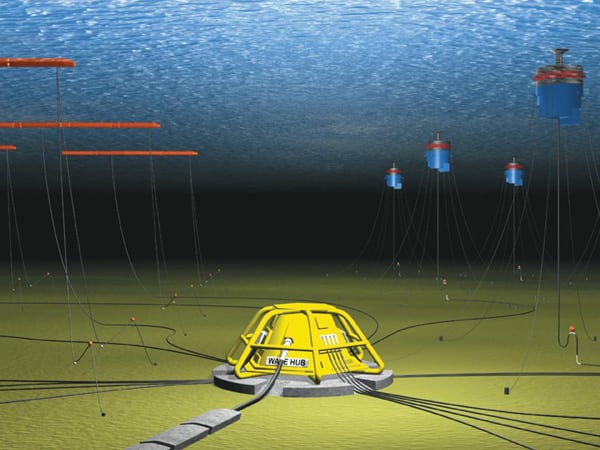UK Installs Hub to Test Wave Energy Projects
A £42 million marine power infrastructure project that will function as an “electrical socket” in waters 50 meters (m) deep and nearly 16 kilometers (km) off the coast of Cornwall in South West England set sail toward its proposed location this July. Dubbed the “Wave Hub,” the 12 metric ton–device will connect groups of developmental wave energy devices to the national grid via a 25-km 33,000-volt subsea cable.
The hub will employ four berths, each covering two square km (Figure 5). These split the main cable to the grid onshore into four 300-m cable “tails” to which groups of wave energy devices can be attached and monitored for how they perform.
 |
| 5. Subsea extension cord. The 20-MW Wave Hub is being installed in waters 50 meters deep and nearly 16 kilometers off the coast of Cornwall in South West England. The 12 metric ton–device will connect groups of developmental wave energy devices to the national grid using four berths. Each covers 2 square kilometers. Courtesy: South West Regional Development Agency |
According to developer South West Regional Development Agency (RDA), the hub will have an initial maximum capacity of 20 MW, but it has been designed to be scaled up to 50 MW. Legal agreements have already been drawn up to use the undersea socket starting in 2011. Ocean Power Technologies Ltd. will take the first berth to test a larger version of its government-funded PowerBuoy wave energy converter, but the RDA is also said to be in talks with a number of other marine energy developers.
The device’s complex installation involves laying cable (burying it under the sand for about 2 km out to sea) and then lowering the hub onto the seabed using a crane. By the start of August, however, the process had already been delayed three times because of equipment failure and weather. A floatation device and part of the cable sank while being floated from land to ship 2 km offshore.
Still, hopes remain high for the project that has received more than half its funding from the European Regional Development Fund Convergence program and nearly £10 million from the UK government. The UK already hosts a research center that focuses on wave and tidal development offshore near the Orkney Islands. The European Marine Energy Center (EMEC) enables a global range of developers and devices, as well as academic institutions and regulatory bodies, to test full-scale grid-connected prototypes in rough wave and tidal conditions.
Among the latest devices to arrive at that test site is a second-generation giant wave energy device built by Edinburgh company Pelamis Wave Power. Nearly 180 m long, the P2 machine is far larger than the original Pelamis prototype previously tested at EMEC in 2004. The device is being tested by E.ON UK—the first major power utility to make use of EMEC’s facilities. E.ON has said that successful tests could result in much bigger arrays of the P2 being built around Orkney.